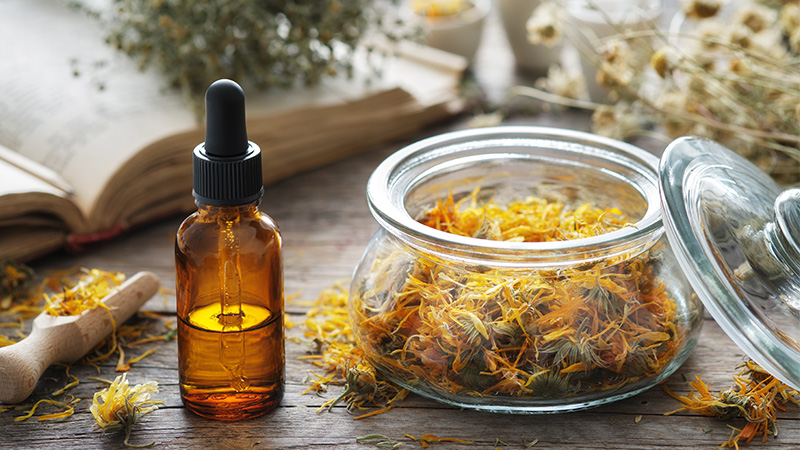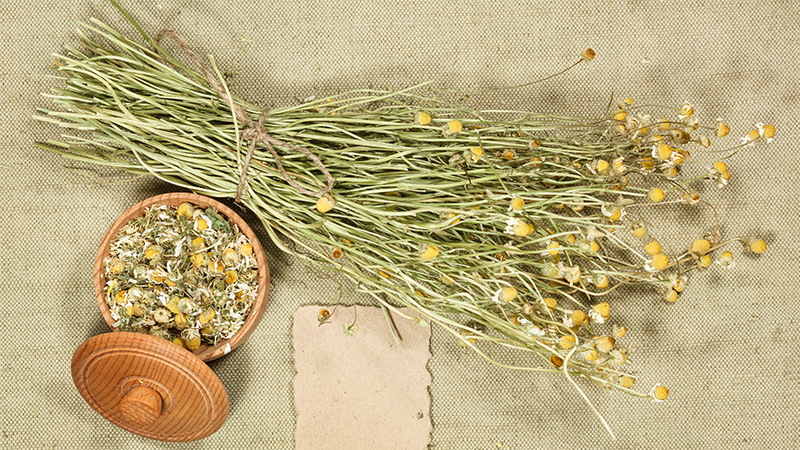How to make your own infused aromatherapy oils

Mid-Summer is an ideal time to make your own infused aromatherapy oils as herbs and flowers tend to be in full bloom. Making these oils – also known as “floral” or “herbal” oils, can be an excellent and inexpensive way of deriving therapeutic benefits from your garden, and makes absolute sense when more of us are focusing on natural products, sustainable living, and self-sufficiency.
Unlike essential oils, infused oils can be easily made at home and are usually very gentle on the skin. They have similar therapeutic properties to essential oils but will also contain the fat-soluble components of the plant too.
They make excellent base oils for massage – without the need to add essential oils, and depending on the strength of the oil (i.e. how much plant material you have infused) they can be used undiluted or added to your massage base at between 5 – 20%. They make excellent bath oils, and can also be used in homemade creams, balms, butters, lotions, salves, hair treatments and soaps!
Which herbs and flowers can you use?
Common herbs and flowers that lend themselves well to making infused oils are as follows:-
Calendula
Has excellent antiseptic, anti-inflammatory properties. Good for soothing and healing many problem skin conditions including acne, inflamed rashes, minor burns (including sunburn), cuts, abrasions, bites, and stings.
Chamomile
Excellent for inflamed, irritated skin conditions, and a mild sedative that can help with anxiety, nervous tension, stress, and poor sleep. Also safe and gentle enough to use with children.
Comfrey
Known for their healing, anti-inflammatory and analgesic effects. Excellent for healing superficial wounds and treating irritated or infected skin conditions. Also thought to be beneficial for bruises, aches, pains, sprains, strains and broken bones.
Lavender
Has a soothing, sedative action that calms nerves, relaxes muscles, eases pain and anxiety and aids sleep. Also good for soothing and healing a wide variety of skin problems and irritations.
Peppermint
Can help to soothe and cool irritated, itchy, and inflamed skin. Also good for muscular aches and pains, headaches and for relieving fatigue.
Rosemary
Good for the hair and scalp and for soothing the muscles and joints. Can also help to relieve fatigue and improve memory and concentration.
St John’s Wort
A natural anti-depressant that is also excellent for a variety of skin problems thanks to its soothing, anti-inflammatory, antiseptic, and analgesic properties. Seek medical advice before using this herb if you are taking any medication.
Roses
Roses are excellent for skincare, helping to soothe, hydrate and rejuvenate the skin. Also good for stress, anxiety, nervous tension, depression and problems related to the female reproductive system.
Preparing your herbs and flowers
Although you can use fresh herbs and flowers, they can introduce water into your oil which can cause it to go off more quickly.
Drying your plant material can therefore help prolong the shelf-life of your oil and also allows you to make up fresh batches of oil when the plants are out of season.
The plants should be dried quickly but without too much heat and should be kept out of direct sunlight as this can destroy the active compounds. There are two basic methods:
- Air drying – gather the plant material in a loose bunch and secure with string or an elastic band. Hang upside down (so the essential oils go into the leaves) in a dry, well-ventilated area and leave for at least two weeks, or until they’ve gone crispy.
- Oven drying – spread the plant material out onto a baking tray covered in greaseproof paper. Place in the oven on its lowest setting with the door slightly open and leave until dry (this can take anything up to five hours).
Once the plants are dry, strip off the leaves and/or flowers, crumble up and store in an airtight container, where they should last for up to 12 months.

If you want to use fresh herbs and flowers, pick them on a dry day after the sun has dried the morning dew and leave to wilt for 12 hours before using. This will help to reduce the moisture content.
Note: St John's Wort is best infused fresh as you can't extract the active component hypericin when dried.
Choosing your base oil
Making an infused oil is a bit like making a cup of tea but using a base oil (or carrier oil) instead of water. There are many oils to choose from, so it can help to think about what you’re going to use the oil for and what you’re infusing it with. Always choose high quality, cold-pressed oils and try to avoid refined or solvent-extracted oils. Popular choices include:
- Sunflower Seed oil is used in approximately 90% of commercial infusions/macerations.
- Grapeseed and Sweet Almond Oil are excellent, cost-effective options that are ideal for massage bases and more delicate floral oils as they have little or no smell. Avoid Sweet Almond oil with nut allergies.
- Jojoba also has no inherent scent and offers a longer shelf-life. It is more expensive but does have a more luxurious feel on the skin.
To learn more or for alternative options browse our full range of carrier oils. We also have a smaller range of organic carrier oils.
Note: If you are infusing oils for culinary use, we would recommend that you purchase food grade (not cosmetic grade) oil from a food retailer.
How to make your infused oil
Once you have harvested your plant material all you need to do is ‘infuse’ it in your chosen base oil to extract its essential compounds and therapeutic goodness.
One of the most important points to remember when making infused oils, is to sterilise your jars and anything you intend to decant the oil with or into. This will help prevent your oil going “off” due to microbes breeding in your mix. Using items straight from the dishwasher is ideal, but just ensure they are completely dry.
If you’re using fresh leaves, chop them up finely as this exposes more plant to the oil and gives a better infusion. Fresh flowers can be used whole and dried plant material is already crumbled (as per the above).
Pack your sterilised jar with your dried plant material and pour in your oil until the material is covered and the jar is almost full to the brim. Run a knife or spoon handle around the inside to dispel any air bubbles before sealing the jar. The oil will oxidise and go rancid if there is too much air left in the jar. If you are using dried plant material it can help to warm the oil slightly first to kick start the process.
Place the jar in a warm area such as a sunny windowsill, airing cupboard, or near a Rayburn or Aga for four to six weeks. If placing in a windowsill some people recommend covering with a paper bag to protect the oil from strong sunlight. Windowsills can get colder at night however which can cause condensation, so it may be best to leave in a place that is consistently warm.
If you wish to create a stronger oil you can double or even triple infuse and replace the plant material when it begins to go brown and translucent. Just remember to use sterile utensils. It may be easier to pour the mix into a sterile bowl, remove the material and then repeat the whole process. Calendula is particularly nice when double-infused. Leave for 3 weeks before straining and repeating the process with fresh flowers and the partially infused oil.
If you’re in a particular hurry, you can also use a double boiler or bain-marie to create your infusion. Use approximately 50-75g of dried herb, or 75-100g fresh herb per 300ml base oil. This may vary as some herbs are more voluminous than others, but the aim is for the oil to just cover the herb.
Keep the heat as low as possible to avoid ‘cooking’ the plant material and gently heat for a couple of hours, stirring every half hour.
When your oil is ready to decant, strain the mixture through a muslin and pour into sterile bottles. Exclude as much air as possible and store in cool dark area (or fridge). If you have used fresh plant material it is best to let the oil settle for a week before using as this will allow any water to collect at the bottom of the jar. You can then pour off the oil into another sterile container and discard the water.
Infused oils will generally keep for six to 12 months if stored correctly. Vitamin E oil can be added as a natural preservative to help prolong the shelf life.
If you don't have the plants in your garden, or the time to infuse your own you can always choose from our selection of infused oils:-
Calendula Infused in Sunflower Seed Oil
Comfrey Infused in Sunflower Seed Oil
St John's Wort Infused in Sunflower Seed Oil
Arnica Infused in Sunflower Seed Oil




